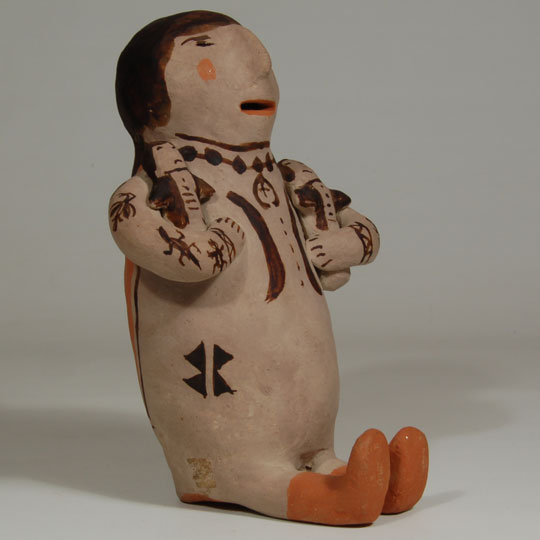
Most tribes also have the figure of the Singing Maiden in their pantheon and in many cases, the mix of Singing Maiden and Storyteller has blurred some lines in the pottery world. Helen's creation struck a chord throughout all the pueblos as the storyteller is a figure central to all their societies. Helen never used any molds or kilns to make her pottery. Then she hand-coiled, hand painted and fired that first storyteller figure the traditional way: in the ground. She gathered her clay from a secret sacred place on the lands of her pueblo. The first real storyteller figure was created in 1964 by Cochiti Pueblo potter Helen Cordero in memory of her grandfather, Santiago Quintana. In most tribes that role was fulfilled by men. So the storyteller's role was to preserve and retell and pass down the oral history of his people. The closest thing they had to a written language was pottery and the designs that decorated that pottery. The "storyteller" is an important role in the tribe as parents are often too busy working and raising kids to pass on their tribal histories and the Native American people did not have a written language to record anything for posterity. The forms of animals, birds and caricatures of outsiders and, more recently, of images of mothers and grandfathers telling stories and singing to children have multiplied. Before and after that time the art of making figurative sculpture flourished, especially at Cochiti Pueblo. However, figures and effigies were denounced as "works of the devil" by the Spanish missionaries in New Mexico between 15. Historically, clay figures have been present in the Pueblo pottery tradition for most of the last thousand years. Most outsiders who visit Cochiti Pueblo these days do so on the way to or from either the recreation area on Cochiti Lake or Kasha-Katuwe Tent Rocks National Monument. Now the white slip comes from one dwindling source at Santo Domingo, Cochiti Pueblo's neighbor to the south. Construction of Cochiti Dam in the 1960's destroyed their primary source of their trademark white slip and gray clay. Today, Cochiti potters face the challenge of acquiring the clay for the white slip. In some pueblos, storytellers are also now made as drummers and as a large variety of animals. The storyteller style was quickly picked up by other pueblos and each modified the form to match their local situation (ie: clay colors and tribal and religious traditions). Helen Cordero is credited with creating the first storyteller in 1964 to honor her grandfather. Most notable is the storyteller, a grandfather or grandmother figure with "babies" perched on it.

An astute observer will find angels, nativities, cowboys, tourist caricatures, snakes, dinosaurs, turtles, goats, two-headed opera singers, clowns, tattooed strongmen, Moorish nuns and even mermaids in the Cochiti pottery pantheon, most produced only since the early 1960's and based on characters described in Cochiti's oral history.Ī few modern potters make traditional styled pots with black and red flowers, animals, clouds, lightning and geometric designs but most Cochiti pottery artists now create figurines. The tribe's contact with the ringmaster, trapeze artists, opera singers, sideshow "freaks" and exotic animals paved the way for a variety of new figural subjects. Legend has it that a Ringling Brothers Circus train broke down near Cochiti Pueblo in the 1920's.

Then production followed the market into more conventional shapes. Then Cochiti potters were among the first to enter the tourist market and they produced many whimsical figures into the early 1900's. That problem left when the Spanish left in 1820 but the fantastic array of figurines created by Cochiti potters was essentially dormant until the railroad arrived. Many of these were condemned as idols and destroyed by the Spaniards. In protohistoric times, human effigy pots, animals, duck canteens and bird shaped pitchers with beaks as spouts were common productions of the Cochiti potters.


 0 kommentar(er)
0 kommentar(er)
